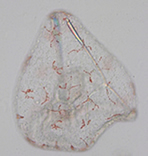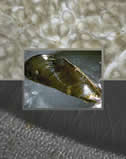Dr. Cristina Calestani
Contact Information
Dr. Cristina Calestani
Professor
Department of Biology
Valdosta State University
1500 N. Patterson St.
Valdosta, GA 31698
Phone: (229) 333-7175
E-mail: ccalestani@valdosta.edu
Curriculum Vitae
Education
- B.S. Biological Sciences, Universita’ degli Studi di Parma, Italy
- M.S. Food Chemistry and Technology, Universita’ degli Studi di Parma, Italy
- Ph.D. Agricultural Genetics, Universita’ degli Studi della Tuscia, Italy
- Post-Doctoral Fellow California Institute of Technology, Pasadena, CA
Research Interests
My research focuses on the study of the molecular and cellular mechanisms that regulate embryo development. My model organism of choice is the sea urchin, a marine invertebrate. In my research program I have adopted a systems biology approach combined with an integrative biology perspective. My primary research interest involves the study of the structure and function of gene regulatory networks (GRNs) acting from fertilization to the formation of differentiated tissues.
1. Study of the sea urchin Gene Regulatory Network (GRN) for pigment cell development
 I have been studying the development of a group of sea urchin mesodermal cells as a model to gain a mechanistic insight into developmental GRNs. The interesting aspect of this embryonic territory is that a small group of mesenchymal cells ultimately develops four different cell types (i.e., pigment cells, blastocoelar cells, muscle, and coelomic pouches). Little is known about the genetic pathways that regulate the alternative cell-fate decisions involved in this process. Since pigment cells are the first cell type out of these four to be specified, I have first focused my initial research on this cell type.
I have been studying the development of a group of sea urchin mesodermal cells as a model to gain a mechanistic insight into developmental GRNs. The interesting aspect of this embryonic territory is that a small group of mesenchymal cells ultimately develops four different cell types (i.e., pigment cells, blastocoelar cells, muscle, and coelomic pouches). Little is known about the genetic pathways that regulate the alternative cell-fate decisions involved in this process. Since pigment cells are the first cell type out of these four to be specified, I have first focused my initial research on this cell type.
2. Study of the sea urchin pigment cell function
 I believe that, in order to gain a better understanding of the developmental GRNs mechanistics and evolution, it is of great importance to integrate the molecular biology studies with the study of the cell’s biological function. Natural selection directly acts on phenotypic variation and the maintenance of this variation will depend upon the functionality of different cell types/tissues/organs. The most supported hypothesis about pigment cell function is that they may be involved in the immune-defense of the larva. The study of the sea urchin’s immune system is of great interest to the biomedical field because sea urchins are long-lived animals, some up to 200 years. The morphology and behavior of pigment cells are, to some extent, similar to that of macrophages, and the sea urchin pigment (echinochrome) has antibiotic properties against various marine and non-marine bacteria. I previously determined that a polyketide synthase (PKS) is required for the biosynthesis of the echinochrome pigment, which further support an immune-function for pigment cells. PKSs are mainly found in bacterial, fungi, and plants, and they synthesize a wide array of compounds of great interest to the pharmaceutical field for their broad spectrum of biological activities, such as antibiotic, antitumor, antifungal, and immunosuppressive. To gain comprehensive knowledge regarding pigment cell function we are working to identify the set of genes involved in the development of the immune function of pigment cells, and to obtain high resolution imaging of pigment cells’ behavior in response to pathogens.
I believe that, in order to gain a better understanding of the developmental GRNs mechanistics and evolution, it is of great importance to integrate the molecular biology studies with the study of the cell’s biological function. Natural selection directly acts on phenotypic variation and the maintenance of this variation will depend upon the functionality of different cell types/tissues/organs. The most supported hypothesis about pigment cell function is that they may be involved in the immune-defense of the larva. The study of the sea urchin’s immune system is of great interest to the biomedical field because sea urchins are long-lived animals, some up to 200 years. The morphology and behavior of pigment cells are, to some extent, similar to that of macrophages, and the sea urchin pigment (echinochrome) has antibiotic properties against various marine and non-marine bacteria. I previously determined that a polyketide synthase (PKS) is required for the biosynthesis of the echinochrome pigment, which further support an immune-function for pigment cells. PKSs are mainly found in bacterial, fungi, and plants, and they synthesize a wide array of compounds of great interest to the pharmaceutical field for their broad spectrum of biological activities, such as antibiotic, antitumor, antifungal, and immunosuppressive. To gain comprehensive knowledge regarding pigment cell function we are working to identify the set of genes involved in the development of the immune function of pigment cells, and to obtain high resolution imaging of pigment cells’ behavior in response to pathogens.
3. Study of the reproductive biology of the mussel Mytella charruana: sex reversal in response to food availability.
 Mytella charruana is a mussel species that is currently invading the US Southeastern coastline. My laboratory made the very interesting discovery thatthe adult individuals have the ability to switch sex in response to food availability. In the condition of starvation, most of the adult mussels within a population change sex from female to male, possibly as an energy saving mechanism. As a developmental biologist, I find very exciting the question of how an environmental factor (nutrition) can regulate in an adult individual thedevelopmental switch between two cell types as different as the egg and the sperm. Mussels may prove to be a new model organism in the study of alternative sexuality and, specifically, of the relationship between nutrition and sex determination, which is largely unknown. Our long-term goal for this project is to employ molecular biology techniques to uncover what genes are involved, as well as to determine how the genetic pathways regulatinggametogenic cell proliferation and/or differentiation respond to nutrition.
Mytella charruana is a mussel species that is currently invading the US Southeastern coastline. My laboratory made the very interesting discovery thatthe adult individuals have the ability to switch sex in response to food availability. In the condition of starvation, most of the adult mussels within a population change sex from female to male, possibly as an energy saving mechanism. As a developmental biologist, I find very exciting the question of how an environmental factor (nutrition) can regulate in an adult individual thedevelopmental switch between two cell types as different as the egg and the sperm. Mussels may prove to be a new model organism in the study of alternative sexuality and, specifically, of the relationship between nutrition and sex determination, which is largely unknown. Our long-term goal for this project is to employ molecular biology techniques to uncover what genes are involved, as well as to determine how the genetic pathways regulatinggametogenic cell proliferation and/or differentiation respond to nutrition.
Selected Publications
Perillo M, Oulhen N, Foster S, Spurell M, Calestani C, Wessel G. Regulation of dynamic pigment cell states at single-cell resolution (2020). Elife 9:e60388. doi:10.7554/eLife.60388
Calestani C., Dean, P. and Li X. (2018). Identification of three required positive cis-regulated inputs of the sea urchin pigment cell gene polyketide synthase 1. Georgia Journal of Science, 76, No. 2, Article 6.
Calestani C. and Wessel G.M. (2018). These colors don’t run: regulation of pigment biosynthesis in echinoderms. In: Marine Organisms as Model Systems in Biology and Medicine, Results and Problems in Cell Differentiation. Eds: Drs. Malgorzata Kloc and Jacek Z. Kubiak. Springer International Publishing AG. 65:515-525.
Barsi J.C., Tu Q., Calestani C. and Davidson E.H. (2015). Genome-wide assessment of differential effector gene use in embryogenesis. Development, 142, 3892-3901
Calestani C., Moses M.S., Maestri E., Marmiroli N., Bray E.A. (2015). Constitutive expression of the barley gene aba2 enhances Arabidopsis germination in response to salt stress. Int. J. Plant Biol., 6, 20-27
Beele A. and Calestani C. (2012). Expression pattern of polyketide synthase-2 during sea urchin development. Gene Expr. Patterns, 12, 7-10. Epub 2011 Oct 5.
Calestani C. and Rogers D. (2010). Cis-regulatory analysis of the sea urchin pigment cell gene polyketide synthase. Dev. Biol. 340, 249-255.
Stenyakina A., Walters L.J., Hoffman E.A., and Calestani C. (2010). Food availability and sex reversal in adult Mytella charruana, an introduced bivalve in the southeastern United States. Mol. Reprod. Dev. 77, 222-230.
Todd A. Castoe, Tricia Stephens, Brice P. Noonan and Calestani C. (2007). A novel group of type I polyketide synthases (PKS) in animals and the complex phylogenomics of PKSs. Gene 392, 47-58.
Sea Urchin Genome Sequencing Consortium (2006). The Genome of the Sea Urchin Strongylocentrotus purpuratus. Science 314, 941 – 952.
Calestani C., Rast J.P., Davidson E.H., (2003). Isolation of pigment cell specific genes in the sea urchin embryo by differential macroarray screening. Development 130, 4587-4596.
Ransick A., Rast J.P., Minokawa T., Calestani C. and Davidson E.H., (2002). New early zygotic regulators of endomesoderm specification in sea urchin embryos discovered by differential array hybridization. Dev. Biol. 246, 132-147.
Davidson E.H., Rast J.P., Oliveri P., Ransick A., Calestani C., Yuh C.H., Minokawa T., Amore G., Hinman V., Arenas-Mena C., Otim O., Brown T., Livi C.B., Lee P.Y., Revilla R., Clarke P.J.C., Rust A.G., Pan Z., Arnone M.I., Rowen L., Cameron R.A., McClay D.R., Hood L. and Bolouri H. (2002). A provisional regulatory gene network for specification of endomesoderm in the sea urchin embryo. Dev. Biol. 246, 162-190.
Davidson E.H., Rast J.P., Oliveri P., Ransick A., Calestani C., Yuh C.H., Minokawa T., Amore G., Hinman V., Arenas-Mena C., Otim O., Brown T., Livi C.B., Lee P.Y., Revilla R., Rust A.G., Pan Z.J., Schilstra M.J., Clarke P.J.C., Arnone M.I., Rowen L., Cameron A.R., McClay D.R., Hood L., Bolouri H. (2002). A genomic regulatory network for development. Science 295, 1669-1678.
Teaching Experience
|
Undergraduate level: |
Graduate level: |
|
Principles of Biology I (laboratory) |
Advanced Genetics |
|
Principles of Biology II (laboratory) |
Developmental Biology |
|
Genetics |
Cell Biology |
|
Genetics for Honor students |
Biology Seminar |
|
Cell Biology |
|
|
Developmental Biology |
|
|
Senior Seminar |
Department of Biology
-
Room 2035, 2nd Floor
Bailey Science Building -
Mailing Address
1500 N. Patterson St.
Valdosta, GA 31698 - Phone: 229.333.5759
- Fax: 229.245.6585
Monday - Thursday
8:00AM until 5:30PM
Friday
8:00AM until 3:00PM
Saturday - Sunday
Office Closed